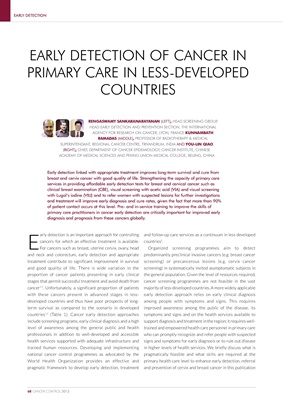
EARLY DETECTION
EARLY DETECTION OF CANCER IN
PRIMARY CARE IN LESS-DEVELOPED
COUNTRIES
RENGASWAMY SANKARANARAYANAN (LEFT), HEAD SCREENING GROUP ,
HEAD EARLY DETECTION AND PREVENTION SECTION, THE INTERNATIONAL
AGENCY FOR RESEARCH ON CANCER, LYON, FRANCE KUNNAMBATH
RAMADAS (MIDDLE), PROFESSOR OF RADIOTHERAPY & MEDICAL
SUPERINTENDANT, REGIONAL CANCER CENTRE, TRIVANDRUM, INDIA AND YOU-LIN QIAO
,
(RIGHT), CHIEF DEPARTMENT OF CANCER EPIDEMIOLOGY, CANCER INSTITUTE, CHINESE
ACADEMY OF MEDICAL SCIENCES AND PEKING UNION MEDICAL COLLEGE, BEIJING, CHINA
Early detection linked with appropriate treatment improves long-term survival and cure from
breast and cervix cancer with good quality of life. Strengthening the capacity of primary care
services in providing affordable early detection tests for breast and cervical cancer such as
clinical breast examination (CBE), visual screening with acetic acid (VIA) and visual screening
with Lugol’s iodine (VILI) and to refer women with suspected lesions for further investigations
and treatment will improve early diagnosis and cure rates, given the fact that more than 90%
of patient contact occurs at this level. Pre- and in-service training to improve the skills of
primary care practitioners in cancer early detection are critically important for improved early
diagnosis and prognosis from these cancers globally.
arly detection is an important approach for controlling and follow-up care services as a continuum in less developed
E cancers for which an effective treatment is available.
For cancers such as breast, uterine cervix, ovary, head
and neck and colorectum, early detection and appropriate
countries5.
Organized screening programmes aim to detect
predominantly preclinical invasive cancers (e.g. breast cancer
treatment contribute to significant improvement in survival screening) or precancerous lesions (e.g. cervix cancer
and good quality of life. There is wide variation in the screening) in systematically invited asymptomatic subjects in
proportion of cancer patients presenting in early clinical the general population. Given the level of resources required,
stages that permit successful treatment and avoid death from cancer screening programmes are not feasible in the vast
cancer1-4. Unfortunately, a significant proportion of patients majority of less-developed countries. A more widely applicable
with these cancers present in advanced stages in less- early detection approach relies on early clinical diagnosis
developed countries and thus have poor prospects of long- among people with symptoms and signs. This requires
term survival as compared to the scenario in developed improved awareness among the public of the disease, its
countries1,2 (Table 1). Cancer early detection approaches symptoms and signs and on the health services available to
include screening programs, early clinical diagnosis and a high support diagnosis and treatment in the region; it requires well-
level of awareness among the general public and health trained and empowered health care personnel in primary care
professionals in addition to well-developed and accessible who can promptly recognize and refer people with suspected
health services supported with adequate infrastructure and signs and symptoms for early diagnosis or to rule out disease
trained human resources. Developing and implementing in higher levels of health services. We briefly discuss what is
national cancer control programmes as advocated by the pragmatically feasible and what skills are required at the
World Health Organization provides an effective and primary health care level to enhance early detection, referral
pragmatic framework to develop early detection, treatment and prevention of cervix and breast cancer in this publication
68 CANCER CONTROL 2013